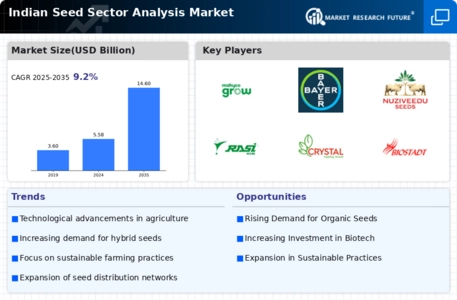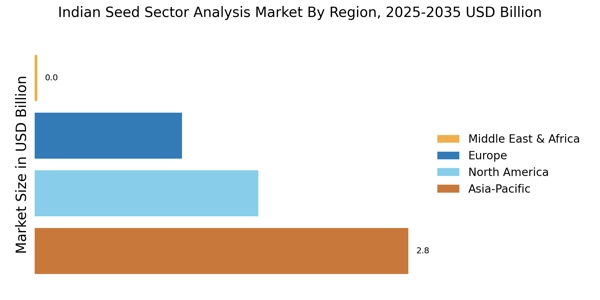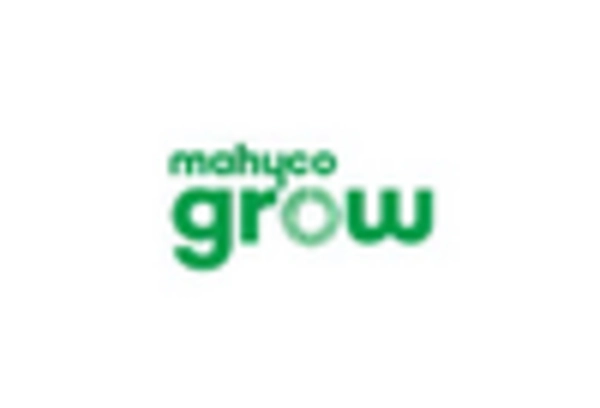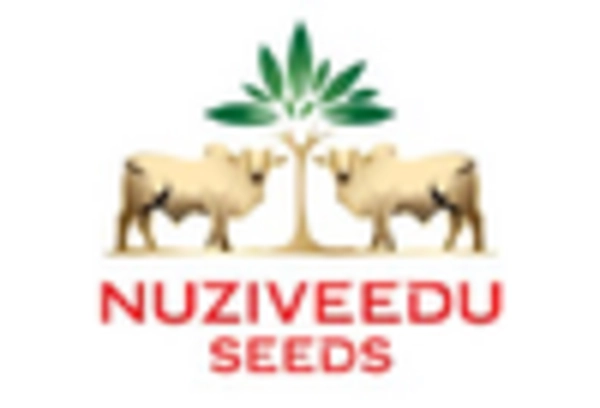Rising Awareness of Biotechnology
The Indian Seed Sector Analysis Market is increasingly influenced by the rising awareness and acceptance of biotechnology among farmers and consumers. Biotech seeds, which are engineered for traits such as pest resistance and drought tolerance, are gaining traction as they offer solutions to some of the pressing challenges faced in agriculture. The market for genetically modified seeds is expected to expand as farmers recognize the benefits of these innovations. Recent estimates suggest that the adoption rate of biotech crops in India could reach 30% by 2027, reflecting a growing confidence in the technology. This shift not only enhances productivity but also contributes to sustainable agricultural practices, thereby reinforcing the importance of biotechnology in the seed sector.
Focus on Organic and Non-GMO Seeds
The Indian Seed Sector Analysis Market is experiencing a notable shift towards organic and non-GMO seeds as consumer preferences evolve. There is a growing demand for organic produce, driven by health-conscious consumers who are increasingly aware of the benefits of organic farming. This trend is reflected in the rising number of organic farms in India, which has increased by over 50% in the last five years. Consequently, seed companies are responding by developing organic seed varieties that cater to this market segment. The emphasis on non-GMO seeds aligns with global trends towards sustainable agriculture, positioning Indian seed producers to meet both domestic and international demands for organic products.
Government Initiatives and Support
The Indian Seed Sector Analysis Market benefits significantly from various government initiatives aimed at bolstering agricultural productivity. Programs such as the National Seed Policy and the Pradhan Mantri Fasal Bima Yojana provide financial assistance and insurance to farmers, encouraging them to adopt improved seed varieties. The government has also established seed banks and research institutions to facilitate the development of new seed technologies. These initiatives are crucial in promoting the use of quality seeds, which is essential for enhancing crop yields. Furthermore, the government's focus on self-sufficiency in food production aligns with the objectives of the seed industry, creating a conducive environment for growth and innovation.
Increasing Demand for High-Yield Varieties
The Indian Seed Sector Analysis Market is witnessing a pronounced shift towards high-yield seed varieties. Farmers are increasingly seeking seeds that promise better productivity and resilience against climatic adversities. This trend is driven by the need to enhance food security and meet the demands of a growing population. According to recent data, the market for hybrid seeds is projected to grow at a compound annual growth rate of approximately 10% over the next five years. This growth is indicative of farmers' preferences for seeds that not only yield more but also require fewer inputs, thereby optimizing their overall agricultural practices. As a result, seed companies are investing heavily in research and development to introduce innovative seed varieties that cater to these evolving demands.
Global Market Trends and Export Opportunities
The Indian Seed Sector Analysis Market is poised to capitalize on emerging global market trends and export opportunities. With the increasing demand for quality seeds in various international markets, Indian seed companies are exploring avenues for export. The Indian Seed Sector Analysis Market is projected to reach USD 100 billion by 2026, presenting a lucrative opportunity for Indian players. The country's diverse agro-climatic conditions allow for the production of a wide range of seeds, making it an attractive source for global buyers. Additionally, the government's push for 'Make in India' initiatives further supports the export potential of Indian seeds, encouraging local companies to enhance their competitiveness on the international stage.


















Leave a Comment